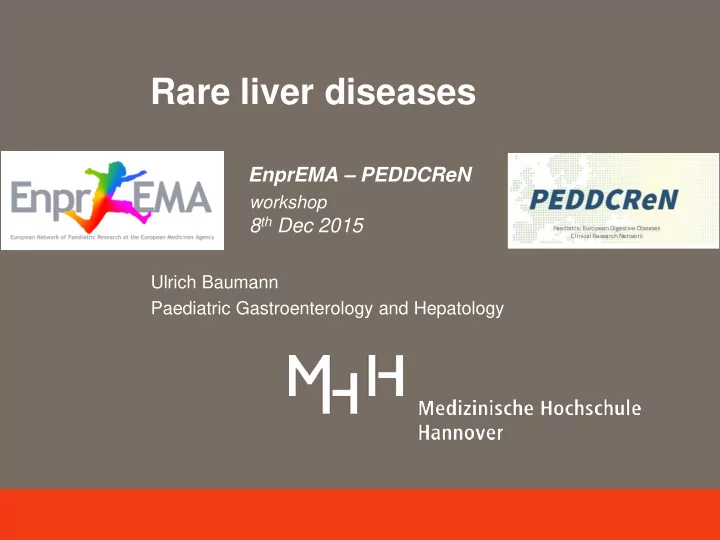

Rare liver diseases EnprEMA – PEDDCReN workshop 8 th Dec 2015 Ulrich Baumann Paediatric Gastroenterology and Hepatology
Conclusion Early recognition of rare disease is paramount for positive outcome Diagnosis and management of rare liver diseases require high degree of specialisation and expertise Networking and exchange between specialised centres are mandatory for optimal patient management
Rare disease – definition: 1 : 2000
Adult experience Prevalence/Incidence of liver disease Alcoholic liver disease 4% Dionysos study, northern Italy HCC : 25.000 new cases per in Europe HCV 1 : 500 Hereditary hemochromatosis 1 : 1000
Comparison: Indication for liver transplantation adult and paediatric practice Paediatric liver transplantation Adult and Paediatric Liver Transplantation Hannover Medical School 1972 - 2013, n=669 Germany, 2009 n=1468 Tumor AIH AIH 2% ALF Biliary atresia 7% 3% 2% 3% Cholangitis 1:10.000 4% 3% ALD PFIC 6% 9% 35% 39% Cryptogenic 12% 15% ALF 16% 20% HCV/HBV 24% HCC Metabolic/cholangiodysplastic (Eurotransplant)
Comparison: Indication for liver transplantation adult and paediatric practice 1:10.000 (Eurotransplant)
Comparison: Indication for liver transplantation adult and paediatric practice 1:10.000 (Eurotransplant)
Rare liver disease • May be – metabolic – congenital – aquired – infectious – other is a diverse and heterogenous entity
How rare is rare….? Biliary atresia Tyrosinaemia Type 1 Crigler Najjar Syndrome 1 : 10.000 1 : 100.000 1 : 1.000.000
Liver-based metabolic disease With structural damage to Without structural damage the liver to the liver • Alpha-1-antitrypsin • Crigler Najjar Syndrome deficiency (1:2500) (1:100.000) • Tyrosinemia Type 1 • Ornitine (1:100.000) transcarbamylase def (1:14.000) • Bile salt export pump def. Primary hyperoxaluria • MDR3 deficiency (1:100.000) (cumulative1:50.000)
Once in a life time….?
IL-21 receptor mutation Kotlarz et al., 2011
Presenting in the neonatal period: Aquired, allo-immune liver disease: Neonatal Haemochromatosis Girl, 2 1/2 months Weight 5,9 kg Explanted liver 190g Incidence: 1 : 3.000.000 (Germany)
Multisystemic disease : Cardiomyopathy in propionic acedaemia 1:150.000 Enlarged atrium as a sign of right venntricular impairment
Age at liver transplantation, single centre experience 1972-2013 (n=669)
Paediatric Hepatology • Small sub-subspecialty – distinct differences to adult hepatology • Metabolic and congenital disease - with emerging new challenges • Many small children – impact on interventions • Focus on transplantation – centre based medicine • Need for collaboration and networking
European Society of Paediatric Gastroenterology, Hepatology and Nutrition
Strengthening collaborative research European Paediatric Liver Transplantation Network EPLTN A network of European specialist centres for paediatric liver transplantation European Paediatric Current projects: Funding: Liver Transplantation • Network grant ESPGHAN 2012 Network EPLTN ChilSFree study Aims: • To foster excellence in research and clinical practice PLTQL study • To obtain meaningful patient numbers Cardiovascular commorbidity trial
Adeno-associated virus vector-mediated liver gene therapy for Crigler-Najjar Syndrome Bosma P 1 , Junge N 2 , Labrune P 3 , d’Antiga L 5 , Brunetti-Pierri N 6 , Ott M 2 , Beuers U 1 , Baumann U 2 , Muro A 7 , Mingozzi F* 4 1 Academic Medical Center, Amsterdam, Netherlands; 2 Hannover Medical School, Hannover, Germany; 3 Assistance Publique - Hôpitaux de Paris, Paris; 4 Genethon, Evry, France; 5 Azienda Ospedaliera Papa Giovanni XXIII, Bergamo; 6 Department of Translational Medicine Federico II University, Napoli; 7 International Centre for Genetic Engineering and Biotechnology, Trieste, Italy GPGE Jahrestagung Berlin 2015 CureCN
European reference networks
Conclusion Early recognition of rare disease is paramount for positive outcome Diagnosis and management of rare liver diseases require high degree of specialisation and expertise Networking and exchange between specialised centres are mandatory for optimal patient management
Primary hyperoxaluria, 1 : 100.000 Debilitating multisystemic oxalate deposits Haffner et al., 1995
Recommend
More recommend